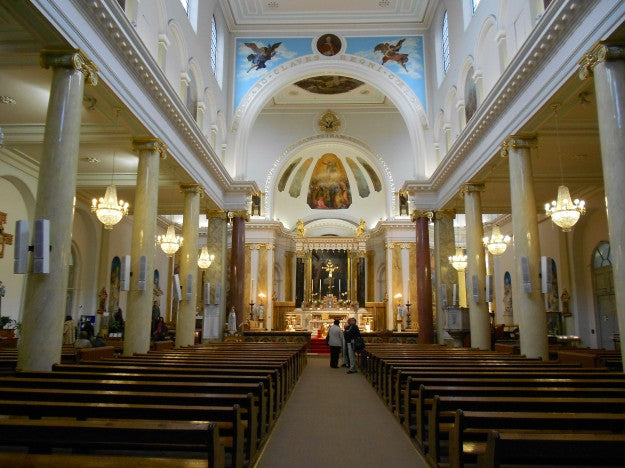Located in Clerkenwell, Islington, Farringdon station was the original terminus of the Metropolitan Railway, when it was opened in 1863. At the present time, it is not a station of great importance, but it was, and will be again, come 2018, when Thameslink trains expand their routes and Crossrail trains come into existence. It does still have a terminus for transporting livestock down to nearby Smithfield Market; however, Smithfield became designated “deadmeat only” just before it came into use. It was last used in 1920, and stands there to this day.

It does have a charming and unspoilt frontage, giving it’s original name (Farringdon & High Holborn), as well as signs for the collection of parcels (see picture).
Oh, and beware the Farringdon mice:

The Italian Church
You might have thought, being so near, we would do Holy Redeemer, Clerkenwell as the church. Well, we aren’t. We are going to do another very Italianate church nearby: the Italian Church of St. Peter.

You might be forgiven for thinking that the only Catholic church in London in strictly Italian style was the Oratory (if you read the spiky ‘blogs, you might be forgiven for thinking that the Oratory was the only church in London). However, this is not the case; there is another, further north, which rejoices under the original and full title of St. Peter of All Nations, but is universally known as the Italian church. It was founded by St. Vincent Palotti, at the request of Cardinal Wiseman, in 1863 (the same year as Farringdon station, interestingly enough), and is staffed by priests of the order which St. Vincent founded. Before the church was built, Italians had been worshipping at the Sardinian embassy: many Catholic churches in London grew out of foreign embassies; the other notable example is St. James, Spanish Place.
It was built by the Irish architect John Miller Bryson, following the plans of Francesco Gualandi of Bologna, which in turn were modelled on the Basilica of San Crisogono in Trastevere, Rome (what is the old joke about the Catholic church in this country being the Italian mission to the Irish?). It boasted some of the finest music in the country in its day, as well as a bell nicknamed the Steel Monster.
The parish life is thriving, and retains a most Italian atmosphere to it. Looking at their website photographs, you can see the distinctly Italian flavour to the processions, especially that of Our Lady of Mount Carmel (they’ve got floats and everything). They also seem to be able to wheel out Cardinals at the drop of a galero.

St. John’s Gate

A wonderful piece of Victorian revivalism, evolution & restoration, this: the church of St. John belonged to the Knights Hospitaller, until they were suppressed in this country, and had to leave somewhat hurriedly after some nasty business during the reformation.

The place then fell into ruin, and existed in several different incarnations over the centuries, including a printing press and a coffee shop which belonged to Hogarth’s father.

When the venerable Order of the Hospital of St. John of Jerusalem was established in the late 1800s, the building was given over to them, and much restored by the likes of Norman Shaw, and it is now a most impressive interior, including the council chambers, all in authentic looking tudor. However, the vast majority of it is Victorian restoration. The also have some lovely vestments, mostly by Comper.

